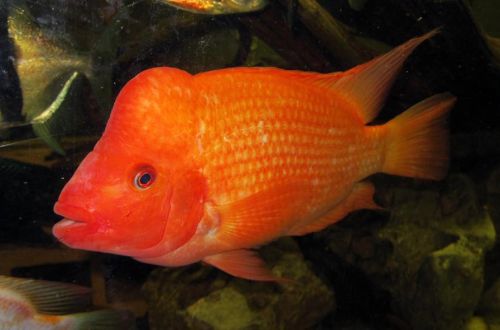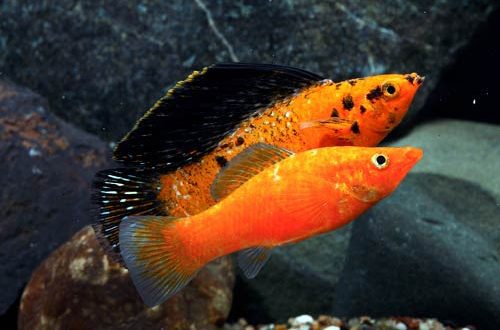
“Red Devil”
The Red Devil cichlid or Tsichlazoma labiatum, scientific name Amphilophus labiatus, belongs to the Cichlids family. This species has many advantages, including an exotic appearance and rich color, unpretentiousness in maintenance and diet, endurance. However, there is also a significant drawback – the extreme degree of aggression. No wonder the colloquial name contains the word “devil”.

Contents
Habitat
Endemic to two lakes, Nicaragua and Managua, located on the territory of modern Nicaragua in Central America. Both lakes are of tectonic origin, connected by the Tipitapa River. Cichlazoma labiatum prefers to stay along rocky coasts, where it swims among crevices.
Note — oz. Nicaragua is the largest freshwater lake in Latin America and the only one in the world where sharks are found.
Brief information:
- The volume of the aquarium – from 350 liters.
- Temperature – 21-26°C
- Value pH — 6.0–8.0
- Water hardness – soft to hard (5-26 dGH)
- Substrate type — stony
- Lighting – moderate
- Brackish water – no
- Water movement – light or moderate
- The size of the fish is 30–35 cm.
- Meals – any
- Temperament – aggressive
- Keeping alone in a species aquarium
Description

Adults reach a length of up to 35 cm. More powerful males have a characteristic occipital hump that distinguishes them from females, as well as elongated and pointed dorsal and anal fins. The color varies from white-yellow to deep orange.
Food
They are not at all whimsical about the diet, they eat everything that can fit in their mouth, including smaller fish. In a home aquarium, the basis of nutrition should be frozen, fresh or live foods, such as earthworms, pieces of snails and other mollusks, shrimps, as well as herbal supplements such as peas, spinach, etc. Specialized foods for large central fish are an excellent alternative. American cichlids produced by some manufacturers.
Maintenance and care, arrangement of aquariums
For one adult fish, an aquarium of 350 liters is required. In the design, fragments of rocks, large stones, gravel substrate are mainly used. There is no need for live plants, if desired, artificial ones can be used. All interior decor should be securely fastened, and equipment should be hidden if possible so that such a large fish cannot damage anything. The aquarium is equipped with a reliable cover. Despite its size, the “Red Devil” is able to jump out of it.
Water parameters have wide acceptable ranges of pH and dGH values, so there are no problems with water treatment. Difficulties are associated only with maintaining high water quality. Filtration and aeration systems are installed based on the need to process large amounts of organic waste and the needs of fish for a high content of dissolved oxygen. A weekly replacement of part of the water (20–25% of the volume) with fresh water is mandatory.
Behavior and Compatibility
One of the most aggressive representatives of cichlids, it attacks not only other fish, but also representatives of its own species. Skirmishes, as a rule, lead to the death of a weaker individual. Joint maintenance is possible only in large aquariums from 1000 liters. As neighbors, fish of a larger size should be selected, which will not be so easily intimidated, and / or reliably protected from among large catfish. An amateur can recommend an exclusively species aquarium.
Breeding / breeding
The process of breeding the “Red Devil” is quite simple. When the mating season comes, the fish will do everything themselves, without the need to create any special conditions or advance the introduction of a special diet.
The main difficulty is that the fish are not compatible with each other and it is extremely difficult to get a pair ready for breeding in a home aquarium. Cichlazoma labiatum is often kept alone due to its large size and aggressive behavior, and if a male is placed in the same tank as a female, she will soon be killed.
There are several ways to get offspring in an artificial environment, but none of them gives a 100% guarantee.
First. Male and female from different aquariums are placed in one and separated by a transparent perforated wall. There is a small chance that in a few weeks the male will get used to it and reduce the degree of aggression, and in the future they will be able to form a temporary pair.
Second. Initially, about 6 young individuals are acquired, which will grow in place. As they grow older, one pair can naturally form, which in the future will regularly give offspring. The chances of pairing increase in proportion to the number of young fish growing together, but this is not the case for the hobby hobbyist.
As a result, it is better to buy this species from professional breeders than to breed it yourself.
Fish diseases
The main cause of most diseases is unsuitable living conditions and poor-quality food. If the first symptoms are detected, you should check the water parameters and the presence of high concentrations of hazardous substances (ammonia, nitrites, nitrates, etc.), if necessary, bring the indicators back to normal and only then proceed with treatment. Read more about symptoms and treatments in the Aquarium Fish Diseases section.





